Over the past few years, there has been a fundamental shift in how we use social media marketing for educational institutions – a trend most evident in the online behaviour of today’s hyper-connected students. Mobile messaging apps like Facebook Messenger, Snapchat, WeChat, and the WhatsApp bot for education have transformed the way we communicate, signalling a mass migration from public social media “broadcasts” to more intimate and private correspondence.
While the popularity of instant messaging (IM) apps first surpassed social networks in 2015 according to Business Insider, it’s projected that in a few years nearly half of humanity will have at least one IM app. Falling prices for mobile devices and data, as well as rapidly expanding features, are some reasons for this growth but it’s also due to wider societal trends. Facebook has long been in decline among teenagers, who are weary of privacy concerns and “drama” from the permanence of posted content. People of all ages have been sharing far fewer personal details on the world’s biggest social network following years of adding random acquaintances from diverse circles – a phenomenon Facebook calls “context collapse”.

Explaining the Growing Popularity of the WhatsApp Bot for Education
Online messaging has grown alongside the widespread global adoption of mobile devices but at an even faster rate. While its fluidity and practicality has made instant messaging popular for over a decade, it was SMS texting that led the way until 2013. Expanding wi-fi accessibility and tech capabilities have enabled chat apps to become multimedia hubs where images, videos and much more can be easily shared, without the expense of SMS charges. New “off-the-grid” or “mesh network” chat messenger apps function without even internet connection or mobile network coverage.
The big appeal of WhatsApp for schools is its frictionless, fast and free capability for sending text and audio messages, images and video to contacts or groups worldwide, and even make free international phone calls. As the preferred messaging app in most emerging markets, it has great potential as an international student recruitment tool, allowing prospective students to instantly correspond with a college or university while receiving links and files to support the decision-making process. In November, it introduced video calling for simple face-to-face conversations with prospects worldwide.
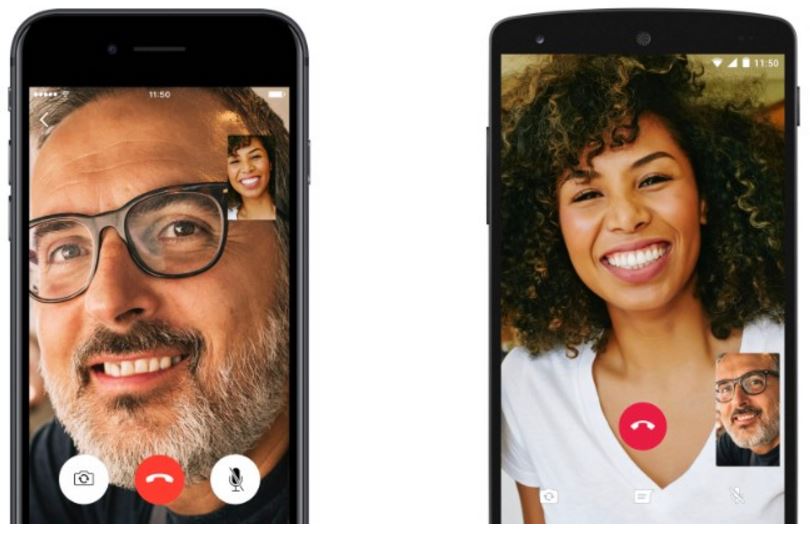
The WhatsApp bot for education has already been adopted by some healthcare institutions to facilitate clinical communications, enhance learning and improve patient care while preserving confidentiality. Studies found that it delivered fast response times, swifter and more efficient patient handovers, and reduced geographic barriers. The spontaneous interaction enabled by WhatsApp was also found to significantly improve engagement and achievement levels among undergraduate nurses.
Benefits of Instant Messaging for Student Recruitment
While online instant messaging is a well known communication channel, few schools have leveraged its full potential for student recruitment. Prospective students, flooded with marketing messages in daily life and targeted ads on social media, value the more human connections fostered by direct, open, two-way communication. The intimacy and relative security of IM makes it the preferred method for sharing personal information, including applications, letters of recommendation or transcripts by attachment.
Its interactive nature is closer to fluid one-on-one conversation than alternatives like email, with instant notifications on constantly connected devices encouraging rapid receipt and response. IM comfortably fits the lifestyles of multi-tasking, hyper-connected millennials, its familiarity encouraging spontaneous follow-up questions at the student’s convenience. The immediacy of correspondence reduces the risk of misunderstandings while conversation threads (end-to-end message history) let either side easily resume discussions without having to hunt for context. These written transcripts can then be archived, monitoring interactions for quality control and opportunities for improvement.
Example: Many schools like Falmouth University include an automatic live chat box on their website, encouraging prospects to connect one-on-one.
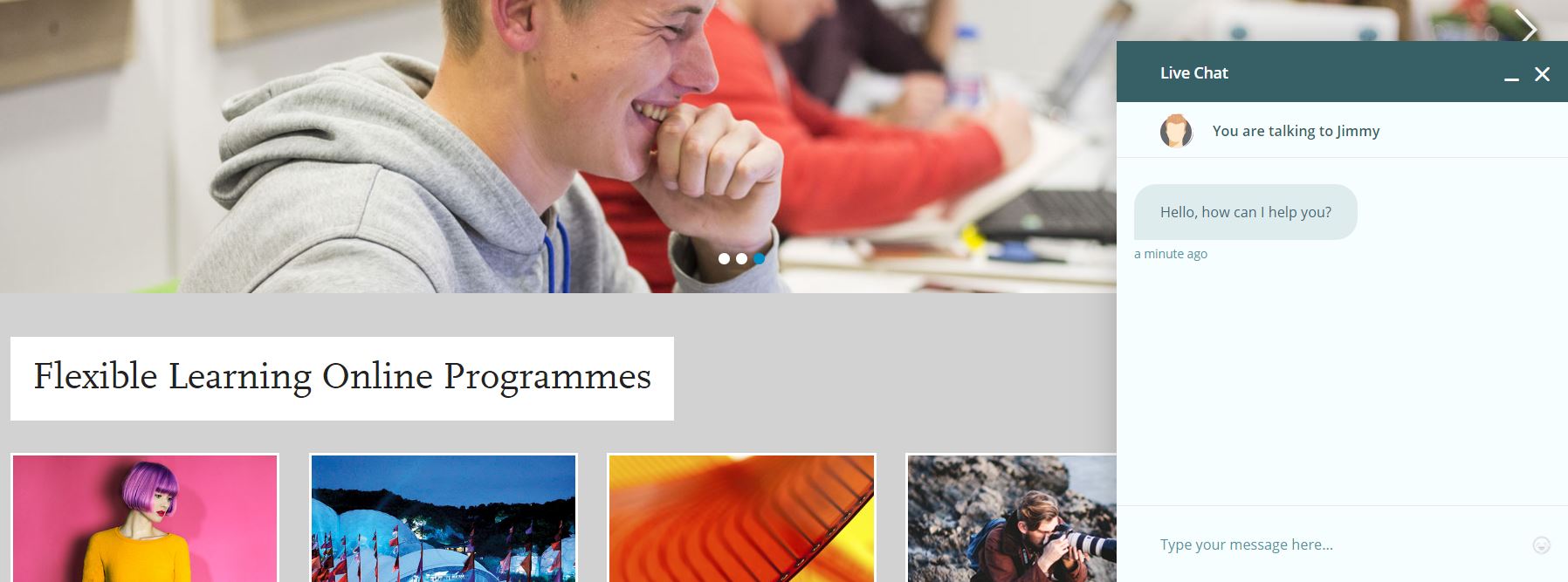
Real-time conversations with IM enable schools to directly understand prospects’ study of interest, motivations and concerns for customized care and conflict resolution. Distinct approaches at different stages of the recruitment funnel can help overcome doubts and spur renewed progress of incomplete applications. It accelerates the ongoing information gathering of both school and student, progressing the admissions process at a time when phones and emails are increasingly going unanswered. IM is undoubtedly an important component of a social media marketing strategy for schools that should be considered.
Guidelines for Effective IM Communications
The key to effective IM communication with students is respecting the relative intimacy of the medium, emphasizing empathetic support that’s as value-added and personalized as possible. Ensure you have a genuine reason for communicating with a prospect via IM on the WhatsApp bot for education (they have already expressed interest in your institution) and that a sufficient relationship has been established so that they know who you are and might appreciate the interaction.
Integrating an effective school CRM (‘customer’ relationship management) allows you to promptly track and follow-up on inquiries, creating detailed profiles of each contact, nurturing leads with strategic content at appropriate times, and automating numerous processes for efficient response. With up-to-date information systems connected to student outreach strategies, you can properly segment prospects to deliver the most relevant and important information.
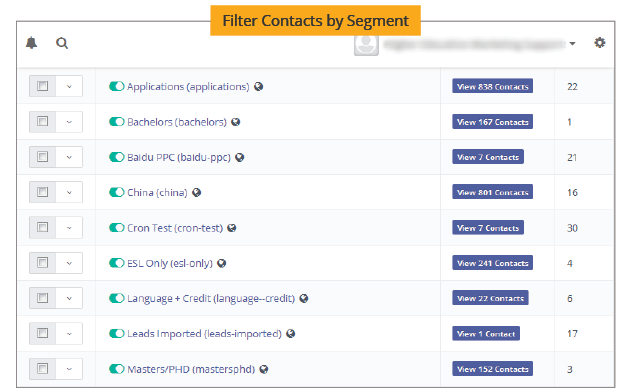
Instant messaging is known for being direct, action-oriented and less formal than email or other communications. Starting conversations with prospects can transform business relationships into personal ones but a delicate balance must be found between professionalism with approachability, being cautious with humour, slang and abbreviations. Emoticons like smiley faces are quickly becoming accepted lexicon for enhancing individuality and expressing context.
Ideas for Strategic Instant Messaging with the WhatsApp Bot for Education
The first step to successfully integrating instant messaging across the student lifecycle is deciding which platforms to use and making them easily accessible. To make use of the WhatsApp bot for education at college fairs and in marketing communications, promote your WhatsApp number and/or Facebook Messenger code to get conversations started. While these are the most popular IM options in much of the world, consider regional preferences depending on your international student recruitment focus:
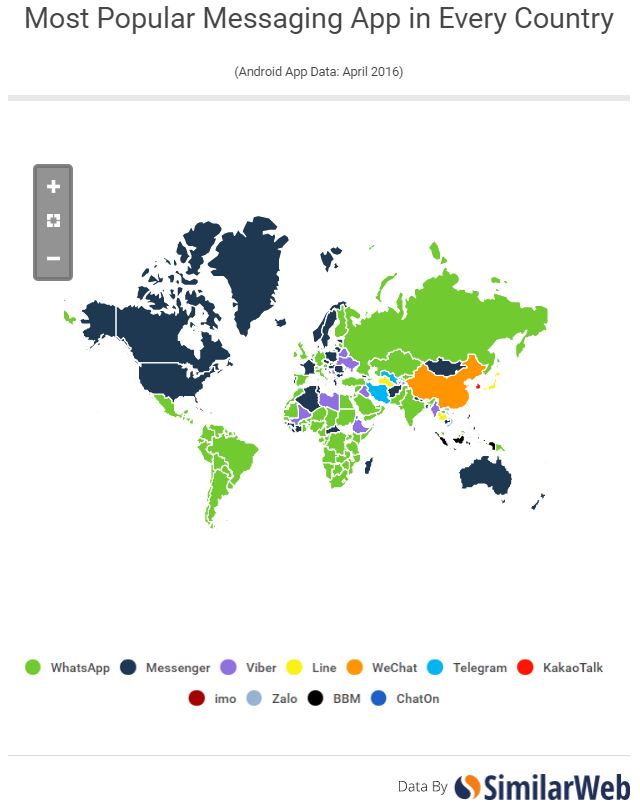
- WeChat is China’s most popular app, with over 800 million monthly users worldwide
- Viber is the most popular messaging app in much of Eastern Europe (as well as Iraq, Libya and Sri Lanka)
- Line is big in Japan and parts of Southeast Asia
- KakaoTalk in South Korea
- Telegram in Iran
Pursuing higher education is a huge decision in anyone’s life and the stakes are raised when crossing the world to do so. Being able to access quick answers to specific questions in the complex admissions process helps prospects overcome various hurdles on the path to enrolment, and this responsiveness can be a significant competitive advantage. Proactively reaching out to prospects earlier in the process to offer help with completing certain tasks or provide reminders about upcoming deadlines can accelerate your admissions – just ensure that students can easily opt out of further correspondence by responding STOP.
There’s no reason why schools can’t nurture relationships throughout the entire student lifecycle with IM. Admitted students will likely eagerly accept IM (and any other support) to simplify their transition to campus. An IM drip marketing campaign can provide this welcome and supporting resources while letting students know they have a direct communication channel available in case of questions. Some schools use simple IM surveys to quickly gauge a prospect’s likelihood of enrolling (their interest on a scale of 1-5), enabling admissions teams to better forecast yields and focus recruitment efforts on undecided prospects.
Sending text “nudges” can positively influence retention of enrolled students by introducing specific campus resources to particular segments, connecting with students at risk of dropping out, and promoting participation in various events, activities or contests. After graduation, occasional updates or event invitations can nurture ongoing connections with alumni.
Improving Efficiency of Your Campaigns with the WhatsApp Bot for Education
You’re probably wondering how you can possibly scale these interactions to send personal messages to every one of your international prospective students. Fortunately, WhatsApp has a broadcasting feature that lets you send mass messages to up to 250 contacts who have saved your number in their address book, without sharing recipients’ details (like a BCC). This can be helpful for sending reminders about upcoming events or deadlines but must be used only sparingly for carefully segmented audiences to avoid having your number blocked.
Managing these types of communications is significantly simplified by using WhatsApp’s web-based service so you can access it on your office computer. It now works with most web browsers and just requires your dedicated mobile number to be connected to the internet. Schools can easily attach files or copy and paste links directly from their computer into messages, and integrate with their CRM.
Optimizing Facebook Messenger for Student Recruitment
As most schools already have an active Facebook account, taking advantage of the network’s latest messaging capabilities should be a digital marketing priority. Facebook Messenger is the most popular chat app in North America and just behind WhatsApp worldwide. It’s rapidly adding new features, including gaming and photo functionality similar to Snapchat, creating more possibilities to engage with students.
Optimizing Messenger is a great way to improve your social media marketing campaigns, more easily track and respond to comments, and provide responsive student support. It also gives you a simple option to private message people who comment on your page, taking conversations offline without leaving the platform to follow up on expressed interest or to defuse complaints.
This messaging is only possible once you’ve first enabled the Message button under General Settings:
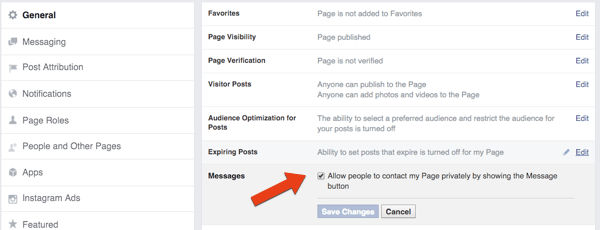
Configuring message settings lets you create a welcome greeting for instant replies and automate answers to frequently asked questions. If a new prospect clicks your “Send Message” button they’ll then receive a customizable welcome message (up to 250 characters), prompting them to start the conversation. A “Save Replies” feature helps admissions teams answer FAQs more quickly, which can be automatically personalized to include the student’s name, the admin’s name or your website’s URL. Using Facebook for schools helps you personalize the experience by displaying bio details from the sender’s profile next to their message, giving you the option to add keywords and notes for reference.
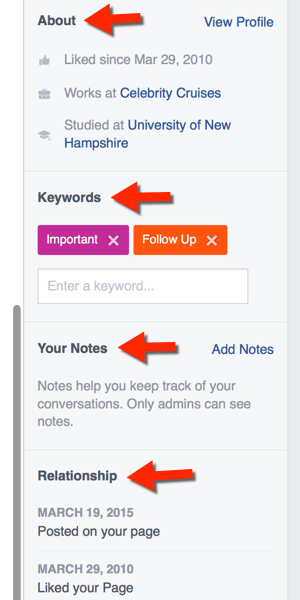
Are Chatbots and the WhatsApp Bot for Education the Future of Instant Messaging?
Our digital era is associated with instant gratification, and millennials are known to have a particular expectation for on-demand responses. Given two similar universities, Hotcourses Abroad found that prospective students from China, India, Thailand, Vietnam and Singapore would choose the one that responded fastest.
Integrating your instant messaging accounts with a social media marketing dashboard can help manage this responsiveness but it can get quite complicated when you’re dealing with hundreds or thousands of students in various time zones across the world. Even domestically, the University of Nebraska found when they offered 24/7 academic support that nearly 90% of messages came between 6pm and 6am.
Chatbots are the newest way that companies and a few pioneering higher education institutions are communicating with students. These tools are touted to enable immediate, two-way conversations for more common requests, freeing admissions staff up to focus on the relatively few interactions that require a closer human touch. Through supervised machine learning, they can continuously improve the quality of their conversations, replying to more and more messages over time.
While virtual assistants like Siri have been popular on smartphones for five years, all the biggest tech companies are now investing heavily in bot development. Facebook announced last April that Messenger now supports chatbots, with tens of thousands already in production, and is developing an associated analytics system. For these chatbots to be successful like the WhatsApp bot for education, they’ll need to deliver accurate, timely and relevant content, reliably passing off the conversation to a live agent when the student isn’t satisfied with an answer, who will have access to the detailed chat history.
Example: Georgia State University, in association with edtech startup AdmitHub, launched the first university chatbot of its kind last April, engaging in conversations incoming students to guide them through key steps like registering for classes and applying for housing. Named “Pounce” after the GSU Panthers’ mascot, it exchanged nearly 50,000 texts with 3,000 admitted students in its first month, routing less than 1% of messages to Georgia State staff for personal follow-up.
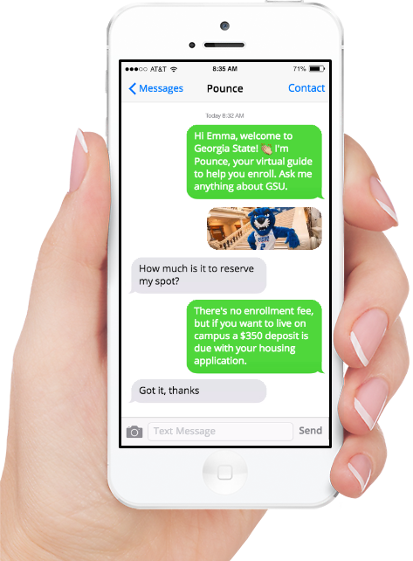

What has been your school’s experience with instant messaging for student recruitment so far?





